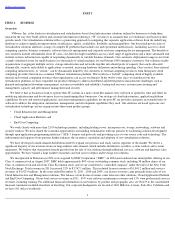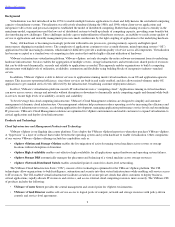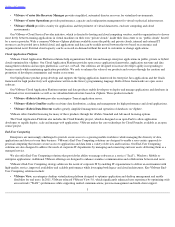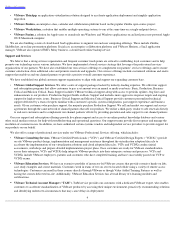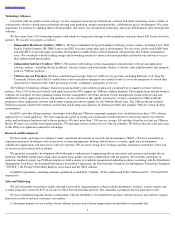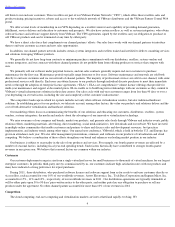VMware 2011 Annual Report Download - page 16
Download and view the complete annual report
Please find page 16 of the 2011 VMware annual report below. You can navigate through the pages in the report by either clicking on the pages listed below, or by using the keyword search tool below to find specific information within the annual report.
Table of Contents
Also, as more and more businesses achieve the virtualization of their data centers and other IT functions, the market for our VMware
vSphere product line may become saturated. If we fail to introduce compelling new features in future upgrades to our VMware vSphere product
line, develop new applications for our virtualization technology or provide product suites based on the VMware vSphere platform that address
customer requirements for integration, automation and management of their IT systems, demand for VMware vSphere may decline.
Additionally, in connection with the announcement in July 2011 of our latest update to VMware vSphere, we announced a change to its
pricing structure. We expect that the new pricing model, which we began to implement with the general availability of VMware vSphere 5 in the
third quarter of 2011, better aligns with a cloud computing approach, whereby customers can align cost with actual use and value derived, rather
than purely with hardware configurations and capacity. VMware vSphere 5 will continue to be licensed perpetually on a per processor basis.
However, two physical constraints, core and physical RAM, were eliminated and replaced with a single virtualization-based entitlement of
virtual memory, or vRAM, which can be shared across a large pool of servers. Although we believe that our new pricing structure is better suited
to changing trends in enterprise utilization of IT resources as the industry shifts to a cloud computing model, if our customers react adversely to
this pricing structure change, they may consider adopting the products of our competitors or we may need to further adjust our pricing model,
resulting in reduced demand for or revenue from our data center virtualization products. Moreover, if our modeling of the impact of this change
in pricing structure on payment streams from our customers proves to be inaccurate, our revenue and operating margins could be negatively
affected.
Due to our product concentration, our business, results of operations, financial condition, and cash flows would therefore be adversely
affected by a decline in demand for our data center virtualization products.
Our new product and technology initiatives subject us to additional business, legal and competitive risks.
Over the last several years, we have introduced new product and technology initiatives that aim to leverage our virtualization infrastructure
software products into the emerging areas of cloud computing and end-user computing as alternatives to the provisioning of physical computing
resources. In 2010, we introduced the first of our vCenter and vCloud products, which we combined in 2011 with our vShield security product to
create our new Cloud Infrastructure and Management (CIM) Suite offering. Our CIM technologies are designed to facilitate the creation of
secure private clouds. They also enable workload mobility with vSphere-compatible public cloud resources offered by our vCloud partners who
are infrastructure as a service (“IaaS”) providers.
In connection with our 2009 acquisition of SpringSource, we announced our intention to use SpringSource solutions to extend VMware's
strategy to deliver solutions in the emerging PaaS market and have since also acquired GemFire and RabbitMQ as part of our overall PaaS
strategy. Additionally, SpringSource's current offerings and their underlying open source technology position us in the enterprise and web
application development markets. In 2011, we announced CloudFoundry, a VMware-operated developer cloud service and a new open source
PaaS project for the development of applications designed to utilize cloud computing.
Our 2010 acquisition of Zimbra extended our footprint to cloud-based email and collaboration services - a part of VMware's strategy to
extend into the emerging SaaS market. In 2011, we expanded our SaaS offerings, as we acquired Socialcast and SlideRocket, which provide
applications directed toward the collaborative development and sharing of user-generated content within the enterprise. In 2011, we also
acquired Digital Fuel which provides IT financial and business management solutions and we acquired certain assets related to our parent
company's Mozy cloud-based data storage and data services and entered into an agreement with EMC to operate the services on EMC's behalf.
We have also continued to expand and enhance our end-user computing offerings, such as VMware View, and in 2011 announced that our first
Horizon offerings, which include a mobile phone application, are expected to become available in 2012.
The expansion of our offerings to include IT management and automation, IaaS, PaaS and SaaS offerings subjects us to additional risks,
such as the following:
11
• These initiatives may present new and difficult technological challenges. Significant investments will be required to acquire and develop
solutions to those challenges. End users may choose not to adopt our new product or service offerings and we may be unable to recoup or
realize a reasonable return on our investments. In addition, some of our new initiatives are hosted by third parties whom we do not
control but whose failure to prevent such disruptions, failures or breaches may require us to issue credits or refunds or indemnify or
otherwise be liable to customers or third parties for damages that may occur. Any transition of our services from a third party hosting
service to our own data centers would also entail a risk of service disruption during a transition.
• We may be subject to claims if customers of these service offerings experience service disruptions or failures, security breaches, data
losses or other quality issues.
•
The success of these new offerings depends upon the cooperation of hardware, software and cloud hosting vendors to


